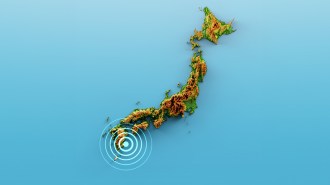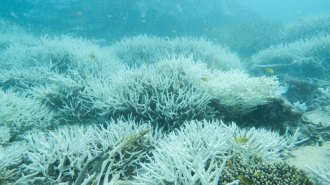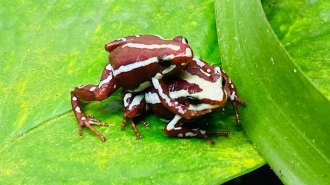News
-
 Earth
EarthWhy Japan issued its first-ever mega-earthquake alert
After a magnitude 7.1 temblor jolted southern Japan, the chances of a subsequent, larger quake occurring in the next week had slightly increased, experts said.
By Nikk Ogasa -
 Earth
EarthSquall line tornadoes are sneaky, dangerous and difficult to forecast
New research is revealing the secrets of these destructive twisters, which dodge radar scans and often form at night.
By Nikk Ogasa -
 Climate
ClimateZigzag walls could help buildings beat the heat
A corrugated exterior wall reflects heat to space and absorbs less heat from the ground, keeping it several degrees cooler than a flat wall.
-
 Astronomy
AstronomySome meteors leave trails lasting up to an hour. Now we may know why
A new survey of meteors that leave persistent trails found that speed and brightness don’t matter as much as atmospheric chemistry.
-
 Earth
EarthEarthquakes added to Pompeii’s death toll
Broken bodies found at the archaeological site indicate that earthquakes played a role in the legendary tragedy.
-
 Climate
ClimateRecord-breaking Coral Sea temperatures threaten the Great Barrier Reef
Near-annual extreme heat in the Coral Sea, including in 2024, is causing back-to-back mass bleaching events in the iconic Great Barrier Reef.
-
 Animals
AnimalsHundreds of snake species get a new origin story
Elapoid snakes, including cobras, mambas and sea snakes, may have evolved in Asia, not Africa as many researchers once thought.
By Jake Buehler -
 Animals
AnimalsWhy a small seabird dares to fly toward cyclones
Tracking data show that Desertas petrels often veer toward cyclones and follow in their wake, perhaps to catch prey drawn to the surface.
-
 Archaeology
ArchaeologyWas Egypt’s first pyramid built with hydraulics? The theory may hold water
A controversial analysis contends that ancient engineers designed a water-powered elevator to hoist stones for King Djoser’s pyramid.
By Bruce Bower -
 Animals
AnimalsPheromone fingers may help poison frogs mate
Specialized glands in the fingertips of some males may produce seductive chemical signals.
By Jake Buehler -
 Neuroscience
NeuroscienceAlzheimer’s blood tests are getting better, but still have a ways to go
Blood biomarker tests could help doctors know if a person's cognitive symptoms are due to Alzheimer's or something else.
-
 Chemistry
ChemistryTycho Brahe dabbled in alchemy. Broken glassware is revealing his recipes
The shards contain nine metals that the famous astronomer may have used, including one not formally identified until 180 years after his death.
By Skyler Ware